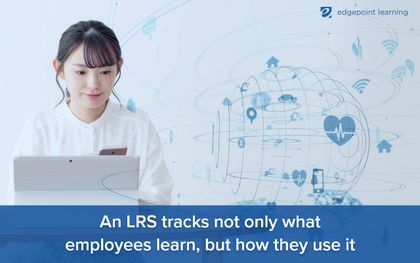How To Transition In-Person Training To eLearning: 9 Steps
Corey Bleich
🍿 4 min. read
Make the transition easier for you and your employees
You have an in-person training program in place, but you know it's time to convert these instructor-led materials into an eLearning training program that employees can complete wherever they are. Here’s how to transition in-person training to eLearning in nine simple steps.
1. Make a short-term plan
Maybe you are moving to eLearning because you just made the decision to move towards a long-term remote workforce. Perhaps you are making a conscious choice to streamline your training materials to make them more responsive to your employees’ needs. No matter why it happens, it’s important to start with a short-term plan.
This might mean starting with virtual instructor-led trainings with the material you have while your team works to put together a full online training plan. Think of this as almost an orientation period where employees can get used to new platforms with some support from a trainer. Since one of the main challenges of eLearning (as opposed to in-person learning) is mastering the technology, this can be a very helpful first step.
2. Perform a training needs analysis
When you move training online, this is a great chance to take stock of where you are—spring cleaning, if you will—with a training needs analysis.
As you do this, consider how many employees need training, which topics to start with, and what's outdated in your current training. You can also change your focus to another area of needs at this point (e.g., upskilling, soft skills, etc.).
3. Plan for phases of development
Before you go any further, you need to have a development plan in place. We cover the basic steps for putting an employee training plan together here.
From there, you'll likely start with your budget. Make sure your C-suite is on board and ready to allocate resources (time, money, and materials) for converting in-person training to virtual training before you take any other steps.
Once the budget is in place, figure out which topics or courses you need to build out first (based on your training needs analysis). Set a timeline for development and implementation that follows the next six steps.
Lay out each phase of development and match it carefully to your desired training outcomes.
4. Determine what you can reuse
Next, when converting in-person training to virtual training consider what resources you already have. Are there any resources you used for IRL training that can convert to an online format?
Although you won’t have as much need for hard copies of longer manuals and training guides, these can be used as a basis for eLearning programs.
For example, policies and procedures that don’t change can be converted to different formats for microlearning or just-in-time performance support. Many of the step-by-step problem-solving exercises previously done in person can be converted to other formats, such as checklists. This step saves both time and money in development.
5. Find a learning platform that fits your needs
Standard learning management systems (LMS) may have worked in the past, but new eLearning platforms offer a richer, more data-driven experience through xAPI-enabled learning record stores (LRS). Unlike the old LMS (which is still a good choice for many businesses!), LRS tracks not only what employees learn but also how they use it.

Switching to an LRS is one of the top eLearning trends this year, but it may not work for every business. Take time to evaluate your best LMS vs. LRS options before moving to the next step.
6. Match the method to the topic
You’ve identified your needs and found a great platform. Now’s the time to decide which types of training suit your material.
For example, microlearning works best when you just need to focus on one specific task. Performance support gives them the knowledge they need right where they are. Gamification is a great tool to keep employees motivated and engaged. Longer courses with activities that fit into an employee’s day work well for more complex topics that can be applied to the job.
Whatever the method, it’s important to recognize (and embrace) the fact that everyone learns differently. Carefully matching the method to the material and giving employees options for learning offers the best chance for successfully converting in-person training to virtual training.
7. Develop your first phase of courses
Developing your first phase of courses might be as simple as uploading already existing materials, or it might require more time and effort.
You don’t necessarily need to develop eLearning whole cloth, though. Although it is possible to transition to eLearning totally in-house, many companies opt to co-develop with a partner in employee training. Some companies choose to outsource this entirely. EdgePoint Learning, for example, has worked with a variety of businesses both small and large to convert their instructor-led training to eLearning (or develop entirely new trainings).
Partnering with a professional can make your roll-out seamless and frees up other resources within your company.
8. Assess what worked, and what didn't
Ever heard the saying about the best laid plans of mice and men? Sometimes, no matter how carefully you plan, you don’t get the outcomes you want.
Take the time to assess what worked in your first round of new training—and what needs tweaking. Employee surveys can be helpful for this, as can measuring performance or implementation. This is not a punitive phase but a way to make sure that the eLearning build-out process is working for everyone who needs it.
9. Back to the development board
This final step takes everything you learned from the first phase of transitioning from in-person learning to eLearning and uses it to improve all the phases that follow. It should be clear that you cannot just take your traditional in-person class and post it online. There is much more to consider, and the correspondence is not one-to-one.
If you still aren’t sure how to transition in-person training to eLearning—or you recognize the wisdom of co-development in the early stages of your transition—contact EdgePoint Learning!
Our team of training specialists can ease the transition to online learning so you can create training that employees love.
